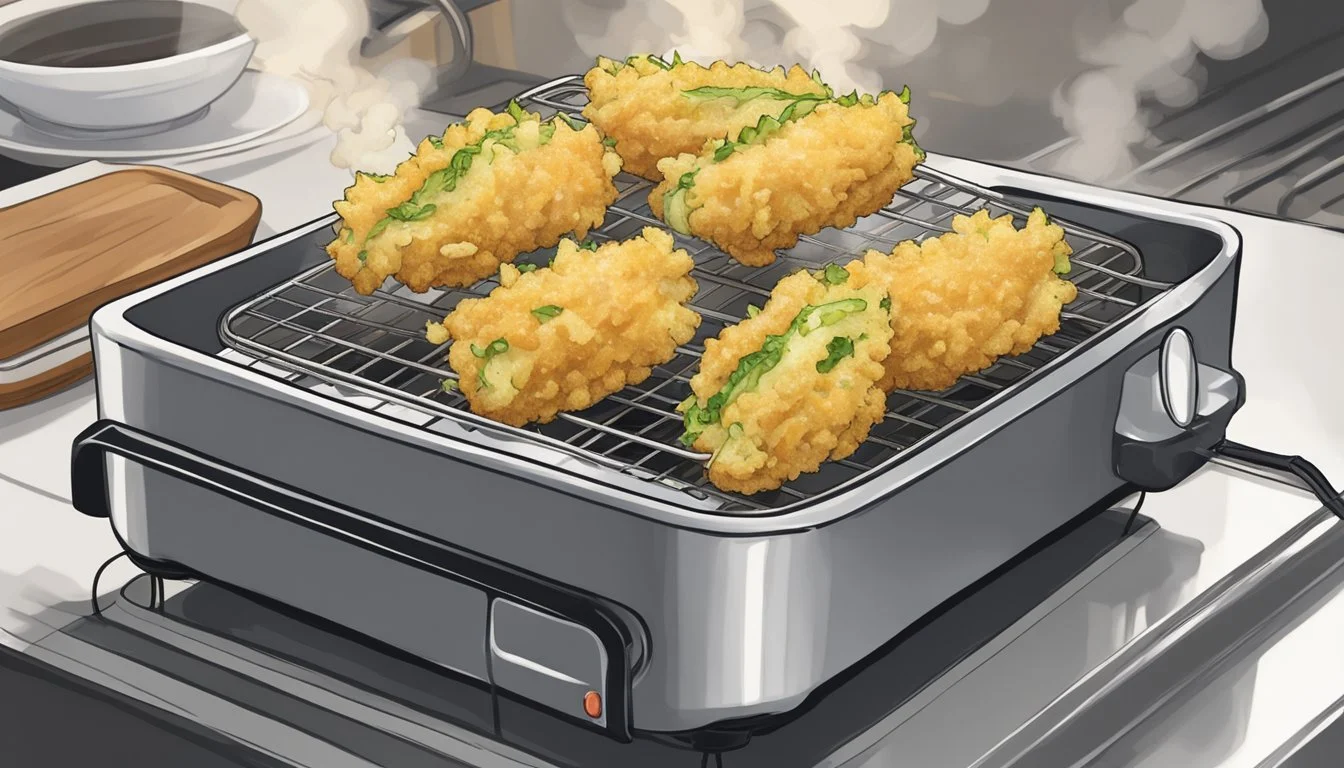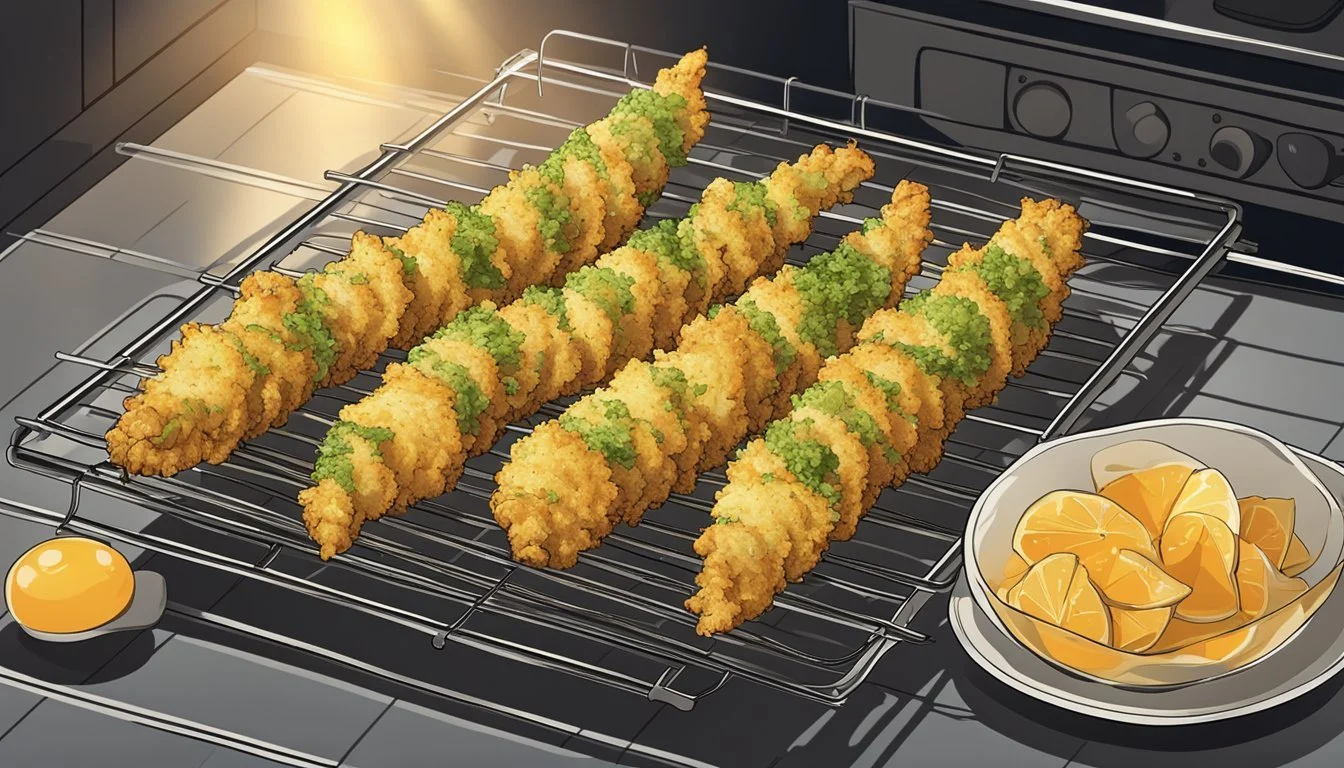Best Way to Reheat Vegetable Tempura
Ensuring Lightness and Crispness
Vegetable tempura, with its light and crispy batter, is a staple in Japanese cuisine known for its delightful texture and flavor. Achieving the perfect crunch when reheating leftover tempura is a culinary challenge that many face, often ending with a soggy or overly dry result. The key to restoring the tempura to its original glory lies in the method used for reheating, ensuring that the batter doesn't lose its crispiness and the vegetables maintain their integrity.
The best approach involves gentle heat and a technique that draws moisture away from the batter. An air fryer, for instance, is a preferred tool due to its ability to circulate hot air around the tempura, mimicking the original cooking process without the need for additional oil. This helps in keeping the batter light and crispy as if freshly made. Precise temperature control and timing are critical to prevent the fine crust from turning hard or burning, while still reheating the vegetables thoroughly.
By understanding the characteristics of the tempura batter and how it reacts to heat, one can select a reheating method that preserves the texture and enhances the flavors of the vegetable tempura. It's not just about bringing the food to an edible temperature but about rejuvenating the tempura to its best state, providing an exceptional eating experience as if enjoying it straight from the fryer.
Understanding Tempura
In exploring the optimal reheating methods for vegetable tempura, it's essential to understand the dish's origins, key components, and the texture-flavor balance that defines its uniqueness.
Brief History of Tempura
Tempura is a beloved Japanese dish that has its roots in the mid-16th century when Portuguese missionaries introduced the concept of batter-frying to Japan. The Japanese adapted these techniques and refined them over the centuries, resulting in the light and crispy tempura known around the world today. Tempura has evolved to include a variety of ingredients such as vegetables, shrimp, seafood, and even chicken.
Key Ingredients in Tempura Batter
The hallmark of tempura lies in its batter. Traditionally, the batter is a simple mixture of egg, flour, and water, with the purpose of enhancing, rather than masking, the flavor of the main ingredient. Specialty flours, like cake flour, cornstarch, or potato starch, are often used to achieve the characteristic lightness. A typical tempura batter recipe might include:
1 egg (lightly beaten)
1 cup ice water (to keep the batter light)
1 cup cake flour (sifted to prevent lumps)
The Importance of Texture and Flavor
Tempura is celebrated for its delicate balance of a light, airy batter and the natural flavors of the core ingredient, whether it's vegetables, fish, or prawns. Common vegetables used include lotus roots, eggplant, mushrooms, and shiso leaves. The batter's temperature and consistency, as well as the oil's heat level, are crucial for achieving the perfect texture—crisp on the outside, tender on the inside—while preserving the nuanced flavor of the ingredient being fried.
Storing Leftover Tempura
Proper storage is crucial for maintaining the quality of leftover tempura. It ensures that the crispy batter does not become soggy and the vegetables remain fresh when refrigerated.
Best Practices for Airtight Storage
When storing leftover tempura, the use of an airtight container is essential. This prevents moisture from seeping in, which can cause the batter to lose its crispiness. Follow these steps:
Cool Down: Allow the tempura to cool to room temperature to prevent condensation.
Separate Layers: Place a sheet of parchment paper between layers of tempura to avoid sticking.
Seal Tightly: Transfer to an airtight container, ensuring a secure lid to block out air.
Refrigeration Techniques
Proper refrigeration techniques contribute to keeping the tempura fresh. Store the airtight container in the refrigerator using these guidelines:
Temperature: Keep the refrigerator set below 40°F (4°C) to inhibit bacterial growth.
Timing: Refrigerate the tempura as soon as it cools, and consume within 24 hours for best quality.
Placement: Position the container in a cooler part of the refrigerator away from the door to maintain a consistent temperature.
The Reheating Process
The success of reheating tempura hinges on the maintenance of its light and crispy batter. Various methods can achieve this result, each with its merits and appropriate techniques.
General Tips for Reheating
When undertaking the reheating of tempura, it’s crucial to avoid moisture. Reheated tempura should ideally regain its original crispness and warmth without becoming soggy. Allowing space between each piece during the process prevents steam from making the batter mushy, and a preheated appliance ensures a quick reheat, preserving the batter’s quality.
Using the Oven for Reheating
To reheat tempura in the oven, one should preheat to around 425 degrees Fahrenheit. A baking sheet lined with parchment paper is recommended to prevent sticking, and tempura should be heated for about 3-5 minutes. This method is conducive for a larger batch of tempura and leads to a uniform crispness.
Reheating Tempura in a Toaster Oven
A toaster oven is suitable for smaller quantities of tempura and operates on similar principles as a conventional oven. Preheating to 425 degrees Fahrenheit and monitoring closely can yield nicely crisped tempura in just a few minutes. One should lay the tempura flat on a toaster oven tray to avoid overlap.
Microwave Reheating: Pros and Cons
Using a microwave for reheating tempura is the least desirable approach when crispness is the goal. While it's the fastest method, it often results in a soft and chewy texture due to steam within the microwave. If one must use a microwave, they should set it to a low power setting and heat in short bursts, checking for warmth.
Deep-Frying for Optimal Crispness
Re-frying tempura in hot oil can restore the batter's crispness but adds more oil to the dish. The oil should be heated to around 350-375 degrees Fahrenheit before the tempura is quickly dipped to warm and crisp without absorbing excess oil.
Using an Air Fryer to Reheat
Reheating tempura in an air fryer requires preheating the device to approximately 350 degrees Fahrenheit. Tempura pieces should be separated in the basket to facilitate airflow, and a 3-4 minute reheating time is adequate. One may need to flip the pieces halfway through to ensure even reheating.
Best Reheating Practices
When reheating vegetable tempura, the goal is to maintain its light, crispy texture without sogging the batter. Proper preparation, oil management, and post-reheating crispiness are paramount.
Preparing Tempura for Reheating
Before reheating, one must ensure that the tempura is at room temperature, preventing excess moisture from steam. It's best to lay out the pieces on a wire rack over a baking sheet to allow air circulation.
Room Temperature: Let tempura sit until it reaches room temperature.
Wire Rack: Place on a rack for even air flow.
Controlling Oil Temperature and Quality
The quality of oil is crucial for a golden-brown finish. Peanut, canola, or vegetable oil are optimal due to their high smoke points, which ensures a crisp exterior without burning. The oil should be heated to a hot temperature range between 350°F to 400°F before submerging the tempura.
Oil Choices: Peanut, canola, or vegetable oil for their high smoke points.
Temperature Control: Maintain oil temperature between 350°F to 400°F.
Ensuring Crispiness Post-Reheating
Once the tempura is reheated, it's imperative to keep it warm and crisp. Drain any excess oil by placing the pieces on a clean wire rack. This prevents any sogginess that may occur on a solid surface and helps preserve the crispy texture.
Drain Excess Oil: Use a wire rack for draining oil.
Keep Warm: To maintain crispness, serve promptly after reheating.
Serving and Presentation
When reheating tempura, achieving the right texture is crucial, but the serving and presentation are just as important for complementing the delicate flavor and crispy exterior of the dish.
Plating Reheated Tempura
One should carefully arrange the reheated tempura on the plate to ensure each piece is visible and enticing. Pieces like kakiage, a mixed vegetable tempura, should be positioned centrally for visual appeal, while individual items like slices of pumpkin can be fanned out around it. The use of a warm plate helps to maintain the tempura's heat without continuing to cook the batter.
Side Dishes and Dipping Sauces
The tempura should be presented with side dishes that contrast and enhance its flavor. A dipping sauce, typically made from a blend of soy sauce, dashi, and a hint of sugar, should be offered in small individual bowls. This dipping sauce complements the tempura by adding umami and a slight sweetness. For balance, serve with a side of steamed rice or a fresh green salad, ensuring the focus remains on the tempura's crispiness.
Additional Tempura Insights
Perfectly reheating vegetable tempura requires attention to detail and an understanding of the delicate nature of tempura batter. It's essential to maintain the lightness and crispiness that distinguishes a quality tempura.
Avoiding Common Reheating Mistakes
Temperature Control: Overcooking is the primary pitfall to avoid. Whether using an oven, an air fryer, or a pan, temperature should be closely monitored. It's key to reheat at a temperature high enough to crisp the batter but not so high as to burn it or turn it soggy.
Ovens should generally be preheated to around 425°F for a brief period of 3-5 minutes.
Air fryers can be set to 350°F to avoid excessive drying or burning, reheating for just 2-3 minutes.
Spacing: In any reheating method, ensure that vegetable tempura pieces are not touching to allow hot air to circulate and evenly crisp every piece.
Healthy Alternatives for Frying
While traditional tempura is deep-fried, health-conscious diners might prefer oven baking or using an air fryer as alternatives to deep-frying. These methods significantly reduce the amount of oil used, offering a lighter version while still aspiring to achieve that desirable crunch. A spritz of oil can emulate the traditional frying method flavor, particularly for vegetables such as sweet potato and other root vegetables typically used in peixinhos da horta, a Portuguese dish that inspired tempura.
Tempura in Japanese Cuisine and Culture
Tempura is more than just a dish; it's an integral part of Japanese cuisine and culture. When prepared freshly made and served in Japanese restaurants, it often accompanies sushi or is savored on its own merit. The practice of eating tempura in a restaurant setting usually ensures the proper technique and temperature control, honoring the dish's tradition and the diner's palate. Restaurant tempura chefs carefully select ingredients and control the timing of the fry to present the perfect light, airy, and crisp exterior that tempura is celebrated for.
Conclusion
The quest to reheat vegetable tempura so that it retains its light and crispy batter is a challenge met with successful strategies. Utilizing an oven or air fryer is the preferred method to achieve desirable results.
In the oven:
Place tempura on a wire rack over a baking sheet.
Heat at 350°F (177°C) until warm, typically 5-10 minutes.
In the air fryer:
Preheat to 350°F (175°C).
Arrange tempura with space between pieces, spray lightly with oil if needed.
Heat for 2-3 minutes, monitoring to prevent burning.
Microwaves are not recommended as they can cause the batter to soften and lose its signature crispiness. It's vital to avoid thawing frozen tempura before reheating, which can also result in a soggy exterior. Keeping the pieces adequately separated and using a wire rack facilitates even reheating and allows any excess moisture to escape, ensuring the tempura returns as close as possible to its original state.
One's preference might dictate the choice between using an oven and an air fryer, but both are robust methods that preserve the delicate crunch of the vegetable tempura. Temperature control and timing are critical to prevent overcooking, which would compromise the quality. By following these guidelines, one can confidently revive leftover tempura, making it nearly as delightful as when it was freshly made.




